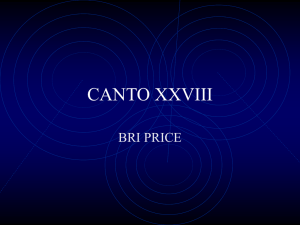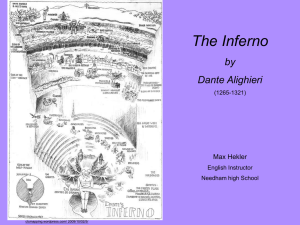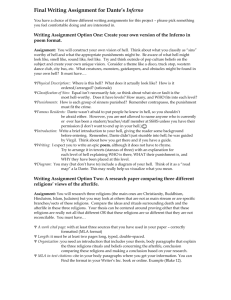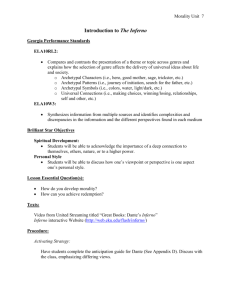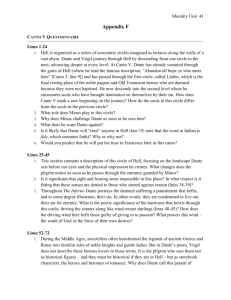Hell, Dante Encyclopedia
advertisement
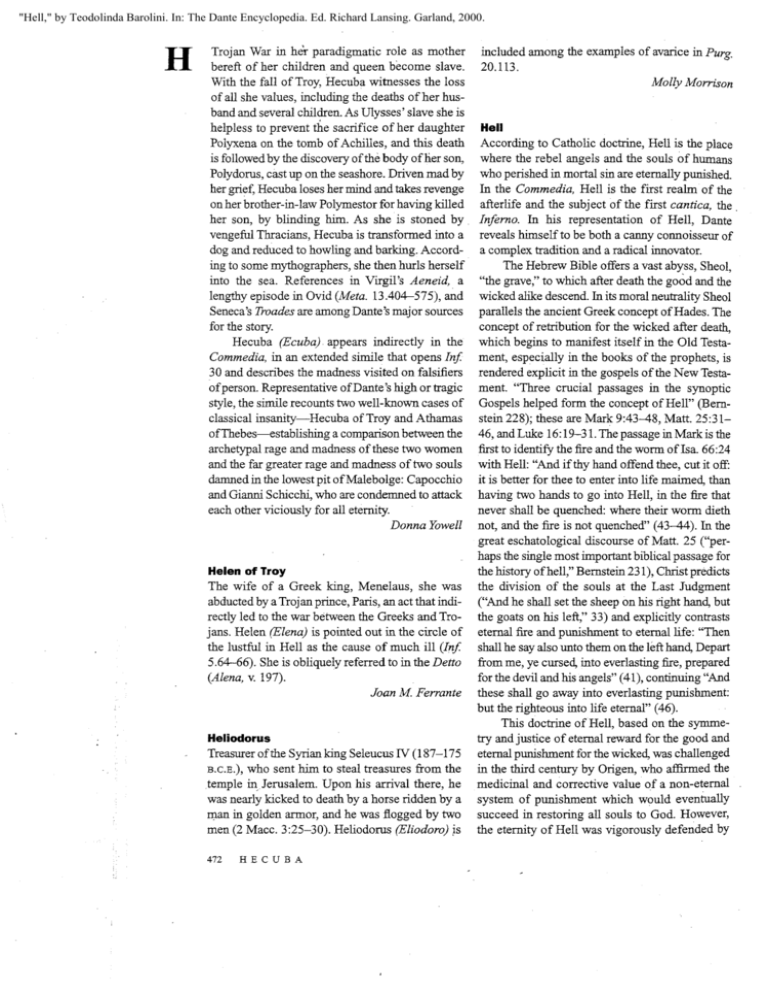
"Hell," by Teodolinda Barolini. In: The Dante Encyclopedia. Ed. Richard Lansing. Garland, 2000.
Trojan War in her paradigmatic role as mother
bereft of her children and queen become slave.
With the fall of Troy, Hecuba witnesses the loss
of all she values, including the deaths of her husband and several children. As Ulysses' slave she is
helpless to prevent the sacrifice of her daughter
Polyxena on the tomb of Achilles, and this death
is followed by the discovery of thè body of Her son,
Polydorus, cast up on the seashore. Driven mad by
her grief, Hecuba loses her mind and takes revenge
on her brother-in-law Polymestor for having killed
her son, by blinding him. As she is stoned by.
vengeful Thracians, Hecuba is transformed into a
dog and reduced to howling and barking. According to some mythographers, she then hurls herself
into the sea. References in Virgil's Aeneid, a
lengthy episode in Ovid {Meta. 13.404-575), and
Seneca's Troades are among Dante's major sources
for the story.
Hecuba (Ecuba) appears indirectly in the
Commedia, in an extended simile that opens Inf.
30 and describes the madness visited on falsifiers
of person. Representative of Dante's high or tragic
style, the simile recounts two well-known cases of
classical insanity—Hecuba of Troy and Athamas
ofThebes—establishing a comparison between the
archetypal rage and madness of these two women
and the far greater rage and madness of two souls
damned in the lowest pit of Malebolge: Capocchio
and Gianni Schicchi, who are condemned to attack
each other viciously for all eternity.
Donna Yowell
Helen of Troy
The wife of a Greek king, Menelaus, she was
abducted by a Trojan prince, Paris, an act that indirectly led to the war between the Greeks and Trojans. Helen (Elena) is pointed out in the circle of
the lustful in Hell as the cause of much ill {Inf.
5.64-66). She is obliquely referred to in the Detto
{Alena, v. 197).
Joan M. Ferrante
Heliodorus
Treasurer of the Syrian king Seleucus IV (187-175
B.C.E.), who sent him to steal treasures from the
temple in Jerusalem. Upon his arrival there, he
was nearly kicked to death by a horse ridden by a
man in golden armor, and he was flogged by two
men (2 Macc. 3:25-30). Heliodorus (Eliodoro) is
472 HECUBA
included among the examples of avarice in Purg.
20.113.
Molly Morrison
Hell
According to Catholic doctrine, Hell is the place
where the rebel angels and the souls of humans
who perished in mortal sin are eternally punished.
In the Commedia, Hell is the first realm of the
afterlife and the subject of the first cantica, the
Inferno. In his representation of Hell, Dante
reveals himself to be both a canny connoisseur of
a complex tradition and a radical innovator.
The Hebrew Bible offers a vast abyss, Sheol,
"the grave," to which after death the good and the
wicked alike descend. In its moral neutrality Sheol
parallels the ancient Greek concept of Hades. The
concept of retribution for the wicked after death,
which begins to manifest itself in the Old Testament, especially in the books of the prophets, is
rendered explicit in the gospels of the New Testament. "Three crucial passages in the synoptic
Gospels helped form the concept of Hell" (Bernstein 228); these are Mark 9:43-48, Matt. 25:3146, and Luke 16:19-31. The passage in Mark is the
first to identify thefireand the worm of Isa. 66:24
with Hell: "And if thy hand offend thee, cut it off:
it is better for thee to enter into life maimed, than
having two hands to go into Hell, in the fire that
never shall be quenched: where their worm dieth
not, and the fire is not quenched" (43-44). In the
great eschatological discourse of Matt. 25 ("perhaps the single most important biblical passage for
the history of hell," Bernstein 231), Christ predicts
the division of the souls at the Last Judgment
("And he shall set the sheep on hisrighthand, but
the goats on his left," 33) and explicitly contrasts
eternalfireand punishment to eternal life: "Then
shall he say also unto them on the left hand, Depart
from me, ye cursed, into everlastingfire,prepared
for the devil and his angels" (41), continuing "And
these shall go away into everlasting punishment:
but the righteous into life eternal" (46).
This doctrine of Hell, based on the symmetry and justice of eternal reward for the good and
eternal punishment for the wicked, was challenged
in the third century by Origen, who affirmed the
medicinal and corrective value of a non-eternal
system of punishment which would eventually
succeed in restoring all souls to God. However,
the eternity of Hell was vigorously defended by
Dante preparing to enter the Gate of Hell From the 1481 edition illustrated by Baldino after sketches by Botticelli, published
in Florence by Nicholo di Lorenzo della Magna. Giamatti Collection: Courtesy of the Mount Holyoke College Archives and
Special Collections.
Augustine, who puts the passage from Matthew
at the center of his argument, noting that "the sentence of the Lord could not be evacuated of meaning or deprived of its force; the sentence, I mean,
that he, on his own prediction, was to pronounce
in these words: 'Out of my sight, accursed ones,
into the eternalfirewhich is prepared for the Devil
and his angels'" (City of God 21.23). Laying the
eschatological foundations of the later Middle
Ages, Augustine writes in the Enchiridion not only
offixedand eternal lots for the bad and the good,
but also of degrees of happiness and misery:
After the resurrection, however, when the
final, universal judgment has been completed,
two groups of citizens, one Christ's, the other
the devil's, shall havefixedlots; one consisting of the good, the other of the bad—both,
however, consisting of angels and men. The
former shall have no will, the latter no power,
to sin, and neither shall have any power to
choose death; but the former shall live truly
and happily in eternal life, the latter shall drag
a miserable existence in eternal death without
the power of dying; for both shall be without
end. But among the former there shall be
degrees of happiness, one being more pre-
eminently happy than another; and among the
latter there shall be degrees of misery, one
being more endurably miserable than another,
(ch. Ill)
Both these concepts—fixed, eternal lots and
degrees of misery for the wicked proportionate to
their sins—are key to Dante's Hell, whose sinners
are distributed through nine circles according to
the gravity of their sins. The eternity of Hell is
solemnly proclaimed by the Gate of Hell itself: Per
me si va ne l'etterno dolore . . . Dinanzi a me non
fuor cose create /se non etterne, e io etterno duro
("Through me the way into eternal sorrow. ..
Before me were no things created except eternal
ones, and I endure eternal," Inf. 3.2, 7-8).
Augustine conceives the wages of sin in terms
of loss and alienation—it is "to be lost out of the
kingdom of God, to be an exile from the city of
God, to be alienated from the life of God"
(.Enchiridion 112). So does Aquinas, who defines sin as,first,"aversion, the turning away from
the changeless good" (aversio ab incommutabili
bono) and, second, as "conversion, the disordered
turning towards a changeable good" (inordinata
conversio ad commutabile bono, ST 1.2.87.4).
Aquinas further teaches that aversion from God
HELL
473
results in the poena damni or "para of loss," which
corresponds to the loss of the beatific vision, while
disordered conversion results in the poena sensus,
or "pain of sense" (ST 1.2.87.4), which corresponds to the torments of hell-fire. These concepts are fundamental to Dante, who holds that sin
alienates us from God—"sin alone is that which
unfrees" us and renders us "dissimilar from the
highest good" (Par. 7.79-80)—and who structures
his poem around a metaphor (life as a path or journey) that embodies the ideas of aversio and conversio: at the beginning of the poem, the pilgrim
has lost the right path andfiguresthe state of aversio, of the sinful soul that has turned away from
God,, in his case temporarily, but with respect to
the sinners of Hell permanently. The notion of sin
as conversio, as a turning toward the changeable
goods of the world, likewise permeates Dante's
thought. It is inscribed into the center of the Cornmedia, in Purg. 16's depiction of the newborn soul
as a female child who, set forth by a happy maker
on the path of life, willingly turns toward all that
brings delight, only to find itself deceived and
seduced by earthly goods: "Dipicciol bene inpria
sente sapore; / quivi s 'inganna, e dietro ad esso
corre, /se guida ofren non torce suo amore " ("Of
some lesser good itfirsttastes the flavor; there it is
deceived and runs after it, if a guide or rein does
not turn away its love," Purg. 16.91-93). And conversio is the centerpiece of the rebuke that Beatrice issues to the pilgrim when they meet at the
top of Mount Purgatory, where she compels him
to acknowledge that after her death "Le presenti
cose / colfalso lorpiacer volser mieipassi" ("Present things with their false pleasure turned aside
my steps, as soon as your face was hidden," Purg.
31.34-35). .
While Dante's conceptualizing of sin, and
ultimately of Hell, is thusfirmlyembedded within
theological tradition, his representation is frequently idiosyncratic to the point of being heterodox. For instance, there is no theological precedent
for creating a vestibule to Hell that houses neutral
angels and cowardly souls "who lived without
infamy and without praise" (Inf. 3.36); nor is there
theological justification for putting virtuous
pagans into Limbo alongside the unbaptized children, or for claiming that certain traitors are
damned before death—their souls sent to Hell
while devils inhabit their bodies on Earth (Inf. 33).
Therefore, although Dante reflects the most
informed theological thought on Hell, hq is cer474
HELL
tainly not constrained by it. By the same token, he
is not limited to the high-culture sources from
which he explicitly borrows, such as Aristotle's
Nicomachean Ethics, which he credits as a source
for the structure of his Hell, or Virgil's underworld
in Aen. 6, various of whose characters and features
he appropriates and transforms. Rather, Dante's
Hell also demonstrates clear links to an established
popular iconography of Hell, as well as to popular cultural forms like sermons, visions, and the
didactic poetry of vernacular predecessors such as
Bonvesin da la Riva and Giacomino da Verona.
Dante's representation of Hell is unique, however,
in its rich and uninhibited blending of these remarkably heterogeneous constituents into a personal vision: for instance, while Aquinas cites
Aristotle in his discussion of sin, and the vision
authors knew the Bible, Dante alone brings together traditions as disparate as the Aeneid and the
Apocalypse of Paul.
The scheme ofDante's Hell. La commedia di Dante, Allighieri,
illustrated by Ugo Foscolo and edited by Giuseppe Mazzini
(London, 1842). Giamatti Collection: Courtesy of the Mount
Holyoke College Archives and Special Collections.
Dante's Hell is a hollow cone excavated by
Lucifer's fall; the displaced matter became Mount
Purgatory (see Inf. 34.121-126 for this highly original account). Situated under Jerusalem, Hell is
made of nine concentric circles that house ever
more grievous sinners; it tapers to a point at the
Earth's core, where Lucifer, the apex of creaturely
sinfulness, is eternallyfixedat lo mezzo /al quale
ogne gravezza si rauna ("the center / toward which
all weight collects," Inf. 32.73-74). The topography of Hell is extensive and varied, embracing
rivers (one of blood), a swamp, a wood, a burning
plain, some landslides, an immense waterfall, a
frozen lake, the fortified turrets of Dis, and the
ditches and bridges of Malebolge. The demography of Hell is likewise extensive, ranging from
biblical and classical characters (a true innovation,
since, as Morgan points out, classicalfigures"are
totally unrepresented in the earlier medieval texts"
[57]) to contemporaries, mainly Italians. Many of
the circles have guardians, which again range from
classical figures (Charon, Minos) and monsters
(the centaurs, Geryon) to contemporary demons.
The order of the nine circles and its underlying
logic are explained by Virgil in Inf. 11, prior to the
descent to the seventh circle, using a schema based
on Aristotle's Nicomachean Ethics (7.1).
Virgil's account makes no mention of the first
circle (Limbo) or the sixth (heresy)—both of
which involve deficient faith and hence have no
place in Aristotle's ethics—and it distinguishes
between sins of incontinence and malice. The sins
of incontinence (circles two throughfive)are sins
of impulse, brought about by immoderate passion
rather than by habit; they are lust, gluttony, avarice
(or prodigality), and anger. The sins of malice
cause injustice and harm to others, either by force
or by fraud (a distinction that Dante finds, as
Moore points out, in Cicero's De ojficiis 1.13).
Injurious acts achieved by fraud are more sinful
becausefraudrequires the misuse of reason, man's
peculiar gift. The seventh circle, then, houses the
violent, while the eighth and the ninth circles contain thefraudulent.Violence is divided into three
subsets; each subset in turn involves two types of
violence: violence against one's neighbor in his
person and in his possessions (tyrants, murderers,
robbers); violence against the self in one's person
and in one's possessions (suicides, squanderers);
and violence against God in his person and in his
possessions (blasphemers, sodomites, usurers).
(Virgil explains that sodomy is violence against
nature, the child of God, while usury is violence
against human art, the child of nature.) Fraud too
is subdivided. The eighth circle contains those who
practiced fraud on the untrusting, distinguished
into ten groups: panders and seducers, flatterers,
simoniacs, diviners, barrators, hypocrites, thieves,
fraudulent counselors, sowers of scandal and
schism, and falsifiers. The ninth and lowest circle
of Hell contains sinners who practiced fraud on
those who trusted them—traitors.
The resulting overlap between the Aristotelian scheme adopted for Hell and the theological
scheme that Dante adopts for Purgatory (where
the seven terraces corresponding to the seven
deadly sins include lust, gluttony, avarice and
prodigality, and anger) displays a uniquely Dantesque contamination of Christian and classical
paradigms—and of popular with high culture, for
Dante is conflating popular religious currents (the
seven deadly sins were not part of Church doctrine
but were important in confession manuals of the
period) with a hyperliterate textual tradition. With
respect to Hell, we could say that an arrangement
that at first seems to be loosely based on the seven
deadly sins is then grafted onto Aristotle, whose
distinction between sins of incontinence and sins
of malice provides the overarching order. (However, while this system of classification is Aristotelian, the material remains fundamentally Christian,
given that "the thirty-seven sins punished in the
Inferno are essentially the same sins as those traditionally represented in the popular visions of the
other world and listed in the confession manuals
of the twelfth and thirteenth centuries" [Morgan,
131].) With respect to Purgatory, where the seven
deadly sins provide the order, the classical/Christian syncretism can be seen in the theologically
unorthodox coupling of avarice with its Aristotelian counterpart, prodigality.
Dante's infernal system of classification is
not without its puzzles and inconsistencies (for
instance, prodigality occurs as a sin of both incontinence and violence, and theft occurs as a sin both
of violence and offraud).On the whole, however,
when one compares the Inferno to the previous
accounts of Hell in vision literature, one is struck
not by its inconsistencies but by the opposite:
Dante's Inferno stunningly conveys the appearance
of a totally inclusive penal systemfromwhich no
sin is omitted and no sinner can escape. Key to creating such an illusion is the deployment of a system of classification that seems quite logical,
HELL
475
precise, and rigorous in its definitions and distinctions, and that invokes the immense authority of
Aristotle. In the confused and unsystematic earlier
visions, where sins and sinners arefrequentlypiled
one on the other with minimal differentiation, the
reader has no way of distinguishing thefirstcategoryfromthe second, third, or fourth^ and consequently little incentive to see who comes next. In
the Inferno, by contrast, we know the order in
which sins will be encountered, as well as the
moral value that has been assigned to each. As a
result, the reader can anticipate the narrative and
is thereby induced to proceed, propelled by the
subliminal desire to see how cogently the author's
rendering will conform to his earlier declarations,
as well as by the urge to participate in a possible
world that seems to make sense, or that can be
challenged if it does not, because its structuring
principles have been made known.
Also key to constructing a persuasive representation of Hell is what Dante calls the contrapasso ("counter-suffering," Inf. 28.142), the
principle whereby the punishment fits the crime.
For Dante, the contrapasso frequently takes the
form of literalizing a metaphor: thus, the souls of
the lustful are tossed by a Hell-storm as in life they
were buffeted by their passions; the schismatics,
who in life rent the body politic, now find their
own bodies torn. Dante's punishments display
remarkable inventiveness and draw from a broad
spectrum of sources, from traditional motifs like
the graduated immersion of a sinner in a river or a
lake (already present in the Apocalypse ofPaul) to
the metamorphosis of man into tree as in Aen. 3.
Overall, Dante effectively deploys the contrapasso
to deflect any sense of randomness or arbitrariness
and to suffuse his text with a feeling for God's
order and justice. In this way, the contrapasso is a
crucial tool in Dante's attempt to represent Hell in
a way that bears out the declaration on its gate—
Giustizia mosse ilmio altofattore ("Justice moved
my high maker," Inf. 3.4)—and in a way that
reflects its true nature: since Hell is deserved separation from God, punishment is not something
inflicted by God but the consequence of the sin
itself. Here too, though some of Dante's punishments may seem more fitting than others, and
some more transparently suggest the sin being
punished, a comparison of Dante's Hell to those of
his precursors reveals that he is the first author to
deploy an ideology of moral decorum not sporadically, but as a systematic feature of his other world.
476
HELL
Ultimately, of course, what most distinguishes
Dante's Infernofromother representations of Hell
is that he creates sinners so complex and alive that
the reader is compelled to sympathize and identify
with them, rather than simply to fear their lot and
resolve to avoid it. While the lessons of earlier
Hells are straightforward—beware, mend your
ways, or this will happen to you—the reader of
Dante's Hell is drawn into a much more sophisticated dance, in which he or she must sort through
the sirens' songs of sinners who are devilishly
attractive and tragically human. Only Dante constructs a Hell in which the reader encounters figures like Francesca, Brunetto, and Ulysses, and is
thereby induced to engage the challenges not just
of death but of life.
Bibliography
Aquinas, Thomas. Summa Theologiae. Ia2ae. Question 87: "The Guilt of Punishment." Blackfriars. Vol. 27. Translated by T. C. O'Brien. New
York: McGraw-Hill; London: Eyre and Spottiswoode, 1974.
Augustine. The Enchiridion on Faith, Hope, and
Love. Edited by Henry Paolucci and translated
by J. F. Shaw. Washington, D.C.: Regnery Gateway, 1961.
Augustine. City of God. Translated by Henry Bettenson. London: Penguin Books, 1972.
Aurigemma, Marcello. "Inferno." Enciclopedia dantesca, 3.432-435.
Barolini, Teodolinda. "Minos's Tail: The Labor of
Devising Hell {Inferno 5.1-24)." Romanic
Review 87 (1996), 437-454.
Bergin, Thomas Goddard. "Hell: Topography and
Demography." In A Diversity of Dante. New
Brunswick, N.J.: Rutgers University Press,
1969, pp. 47-64.
Bernstein, Alan E. The Formation of Hell: Death
and Retribution in the Ancient and Early Christian Worlds. Ithaca, N.Y.: Cornell University
Press, 1993.
Busnelli, Giovanni. LEtica Nicomachea e I'ordinamento morale dell'Inferno 'diDante. Bologna: .
Zanichelli, 1907.
Gardiner, Eileen (ed.). Visions of Heaven and Hell
before Dante. New York: Italica Press, 1989.
Hardwick, E. G. "Hell (Theology of)." In New
Catholic Encyclopedia, vol. 6. New York:
McGraw-Hill, 1967, pp. 1005-1007.
Moore, Edward. "The Classification of Sins in the
Inferno and Purgatorio." In Studies in Dante:
Series. 1899, reprinted New York: Greenwood Press, 1968, pp. 152-209.
Morgan, Alison. Dante and the Medieval Other
World. Cambridge: Cambridge University
Press, 1990.
Piolanti, Antonio. "Inferno." In Enciclopedia Cattolica, vol. 6. Vatican City: Ente per l'Enciclopedia Cattolica e per il Libro Cattolico, 19481954, cols. 1941-1949.
Teodolinda Barolini
Second
Hendecasyllable
The Italian hendecasyllable is by definition a
verse-line often, eleven, or twelve syllables whose
last word-accent falls on the tenth syllable. Since
most Italian words are accented on the penultimate, most hendecasyllables have eleven syllables;
but they can have ten when the last accent is in
word-final position, or twelve if it is on the antepenultimate. Dante's poetry contains instances of
both ten-syllable and twelve-syllable hendecasyllables, but they are very few; the vast majority
have eleven syllables.
How are Dante's hendecasyllables scanned?
With certain exceptions, in the Italian hendecasyllable from the thirteenth century on, all groups
of adjacent vowels count as one syllable, although
each vowel retains some of its distinct articulation. This principle is termed sineresi (synaeresis) when it operates within the word, and sinalefe
(synaloepha) when it operates across word boundaries. When there is a syllable division between
adjacent vowels, the term dieresi (diaeresis) is used
within the word, and dialefe (dialoepha) across
word boundaries. (Sineresi and dieresi are sometimes used more strictly, to describe respectively
counting as one syllable two vowels that would
normally be two syllables, and counting as two syllables two vowels that would normally be one; but
the terms axe used in their looser acceptance here.)
In Dante's practice, as in that of his successors,
sineresi and sinalefe are the normal rule; the latter applies even when a major syntactical division,
represented by a punctuation mark in modern editions, separates vowels that would otherwise be
adjacent.
There are also, however, a large number of
instances of dieresi and dialefe—more than in
Dante's successors from Petrarch on, and applied
less systematically. One set of vowel combinations
always has diaeresis, and as a result .this diaeresis
is usually not marked in modern critical editions:
a, e, or o immediately followed by any accented
vowel, as in paura, leone, ox poeta. The other main
instances of diaeresis (usually marked in modern
critical editions) are as follows: imperfect verb
forms such as avèan, dovèa, facèa, though here
synaeresis is the general rule; verbs with an initial
ri- (from Latin re-) followed by a vowel (here
diaeresis is the rule); some cases of accented u and
i followed by a vowel, such as colui, cui, suo, disio,
fia, io (alongside a much greater number of
instances of the same forms without diaeresis);
and (more consistently) Latinate combinations
involving an initial e, i, or u that preserve the vowel
structure of their origins—empireo, Enea, Pegasèa;
settentrion, trìunfo, viaggio; continuando, intellettiial, perpetua. Beatrice sometimes has diaeresis
but more often does not. Dante's etymological
sense is thus a significant factor in his use of
diaeresis: there is always synaeresis on the Italian
diphthongs ie and uo from Latin e and o.
Dialefe occurs regularly in the Commedia
after polysyllables that end in an accented diphthong or vowel, and after the great majority of
monosyllables, such as e, io, più, è, noi, da, o, but
not after di ("of") or the definite article or proclitic
pronouns (ci, la, le, li, lo, mi, ne, si, ti, vi). Again,
there are a number of exceptions, with no apparent motivation, to the use of dialefe after these categories of forms: about one in ten uses sinalefe
instead. Apartfromthese categories, there are only
about forty instances of dialefe in the Commedia,
afterfinalunaccented vowels in polysyllables, and
for the most part there is no discernible reason
other than the immediate needs of scansion.
Although Dante has a strict sense of the number of
syllables in the verse line, as De vulgari eloquentia shows, and although there is a high degree of
regularity in the way he counts syllables, he uses
considerably more license in this respect than his
successors from Petrarch on.
A semiconsonantal i between two vowels also
produces a syllable division (not properly speaking a diaeresis or dialefe) either inside or at the
beginning of a word, with a very small number of
apparently arbitrary exceptions. In the Commedia,
primaio has both two and three syllables, for
instance, and migliaio has two, in contrast to migliaia, with three.
Italian versification is mainly syllable-based
rather than stress-based like English and German,
so there is nofixeddivision of the hendecasyllable
HENDECASYLLABLE
477

